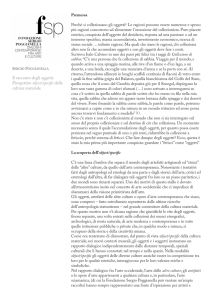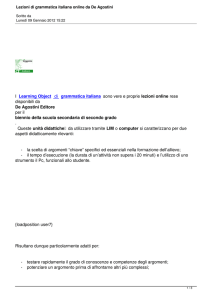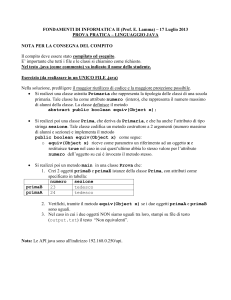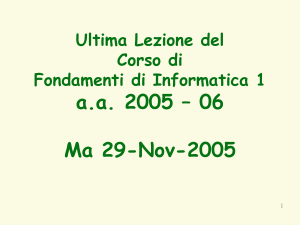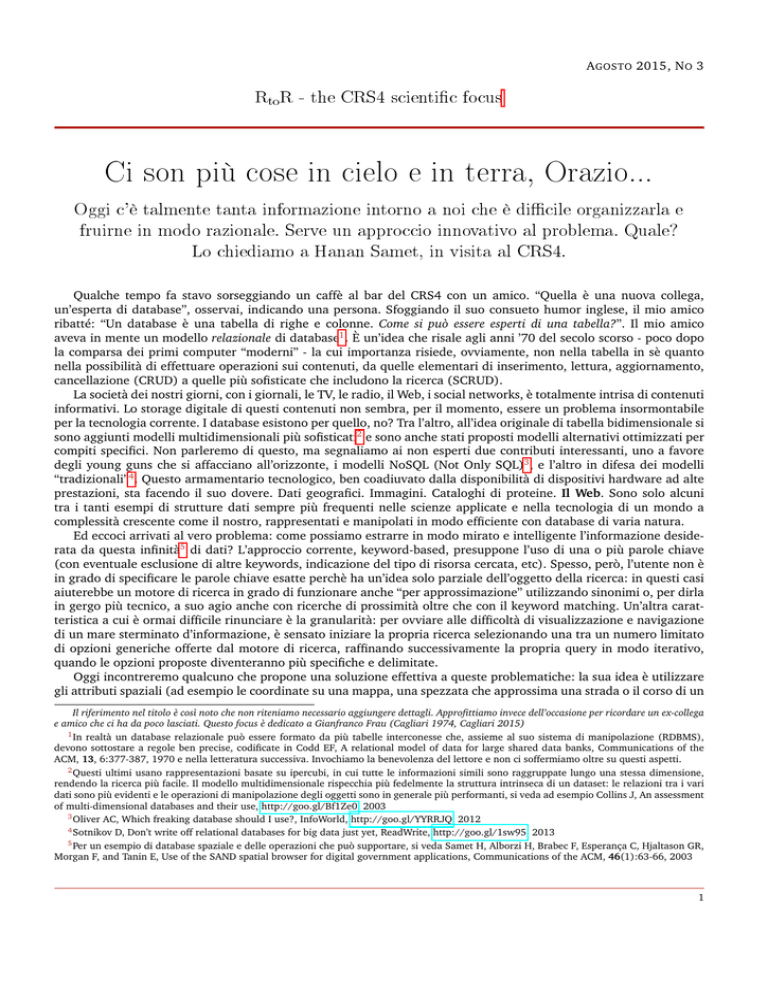
A GOSTO 2015, N O 3
Rto R - the CRS4 scientic focus
Ci son più cose in cielo e in terra, Orazio...
Oggi c'è talmente tanta informazione intorno a noi che è dicile organizzarla e
fruirne in modo razionale. Serve un approccio innovativo al problema. Quale?
Lo chiediamo a Hanan Samet, in visita al CRS4.
Qualche tempo fa stavo sorseggiando un caffè al bar del CRS4 con un amico. “Quella è una nuova collega,
un’esperta di database”, osservai, indicando una persona. Sfoggiando il suo consueto humor inglese, il mio amico
ribatté: “Un database è una tabella di righe e colonne. Come si può essere esperti di una tabella?”. Il mio amico
aveva in mente un modello relazionale di database1 . È un’idea che risale agli anni ’70 del secolo scorso - poco dopo
la comparsa dei primi computer “moderni” - la cui importanza risiede, ovviamente, non nella tabella in sè quanto
nella possibilità di effettuare operazioni sui contenuti, da quelle elementari di inserimento, lettura, aggiornamento,
cancellazione (CRUD) a quelle più sofisticate che includono la ricerca (SCRUD).
La società dei nostri giorni, con i giornali, le TV, le radio, il Web, i social networks, è totalmente intrisa di contenuti
informativi. Lo storage digitale di questi contenuti non sembra, per il momento, essere un problema insormontabile
per la tecnologia corrente. I database esistono per quello, no? Tra l’altro, all’idea originale di tabella bidimensionale si
sono aggiunti modelli multidimensionali più sofisticati2 e sono anche stati proposti modelli alternativi ottimizzati per
compiti specifici. Non parleremo di questo, ma segnaliamo ai non esperti due contributi interessanti, uno a favore
degli young guns che si affacciano all’orizzonte, i modelli NoSQL (Not Only SQL)3 , e l’altro in difesa dei modelli
“tradizionali”4 . Questo armamentario tecnologico, ben coadiuvato dalla disponibilità di dispositivi hardware ad alte
prestazioni, sta facendo il suo dovere. Dati geografici. Immagini. Cataloghi di proteine. Il Web. Sono solo alcuni
tra i tanti esempi di strutture dati sempre più frequenti nelle scienze applicate e nella tecnologia di un mondo a
complessità crescente come il nostro, rappresentati e manipolati in modo efficiente con database di varia natura.
Ed eccoci arrivati al vero problema: come possiamo estrarre in modo mirato e intelligente l’informazione desiderata da questa infinità5 di dati? L’approccio corrente, keyword-based, presuppone l’uso di una o più parole chiave
(con eventuale esclusione di altre keywords, indicazione del tipo di risorsa cercata, etc). Spesso, però, l’utente non è
in grado di specificare le parole chiave esatte perchè ha un’idea solo parziale dell’oggetto della ricerca: in questi casi
aiuterebbe un motore di ricerca in grado di funzionare anche “per approssimazione” utilizzando sinonimi o, per dirla
in gergo più tecnico, a suo agio anche con ricerche di prossimità oltre che con il keyword matching. Un’altra caratteristica a cui è ormai difficile rinunciare è la granularità: per ovviare alle difficoltà di visualizzazione e navigazione
di un mare sterminato d’informazione, è sensato iniziare la propria ricerca selezionando una tra un numero limitato
di opzioni generiche offerte dal motore di ricerca, raffinando successivamente la propria query in modo iterativo,
quando le opzioni proposte diventeranno più specifiche e delimitate.
Oggi incontreremo qualcuno che propone una soluzione effettiva a queste problematiche: la sua idea è utilizzare
gli attributi spaziali (ad esempio le coordinate su una mappa, una spezzata che approssima una strada o il corso di un
Il riferimento nel titolo è così noto che non riteniamo necessario aggiungere dettagli. Approfittiamo invece dell’occasione per ricordare un ex-collega
e amico che ci ha da poco lasciati. Questo focus è dedicato a Gianfranco Frau (Cagliari 1974, Cagliari 2015)
1 In realtà un database relazionale può essere formato da più tabelle interconesse che, assieme al suo sistema di manipolazione (RDBMS),
devono sottostare a regole ben precise, codificate in Codd EF, A relational model of data for large shared data banks, Communications of the
ACM, 13, 6:377-387, 1970 e nella letteratura successiva. Invochiamo la benevolenza del lettore e non ci soffermiamo oltre su questi aspetti.
2 Questi ultimi usano rappresentazioni basate su ipercubi, in cui tutte le informazioni simili sono raggruppate lungo una stessa dimensione,
rendendo la ricerca più facile. Il modello multidimensionale rispecchia più fedelmente la struttura intrinseca di un dataset: le relazioni tra i vari
dati sono più evidenti e le operazioni di manipolazione degli oggetti sono in generale più performanti, si veda ad esempio Collins J, An assessment
of multi-dimensional databases and their use, http://goo.gl/Bf1Ze0, 2003
3 Oliver AC, Which freaking database should I use?, InfoWorld, http://goo.gl/YYRRJQ, 2012
4 Sotnikov D, Don’t write off relational databases for big data just yet, ReadWrite, http://goo.gl/1sw95, 2013
5 Per un esempio di database spaziale e delle operazioni che può supportare, si veda Samet H, Alborzi H, Brabec F, Esperança C, Hjaltason GR,
Morgan F, and Tanin E, Use of the SAND spatial browser for digital government applications, Communications of the ACM, 46(1):63-66, 2003
1
fiume, un area rettangolare che delimita una regione geografica) per indicizzare le informazioni contenute nei database e rendere i motori di ricerca più potenti e flessibili. Certo, se state cercando l’ultimo articolo sulla soluzione delle
bidomain equations 3D con volumi finiti (key search words: “bidomain equations” “finite volumes” 3D -monodomain
filetype:pdf), probabilmente non vi interesserà specificare se il luogo di pubblicazione è la Nuova Zelanda piuttosto
che Milano o Boston, e anche la granularità avrà un peso relativo (non aspettatevi centinaia di migliaia di articoli
sull’argomento). Ma per argomenti più generali e più attinenti la nostra vita quotidiana, l’approccio map query può
fare la differenza. Anche perchè quasi tutti noi abbiamo in tasca un dispositivo potenzialmente in grado di misurare
(e di trasmettere) attributi spaziali legati ai nostri spostamenti: il GPS device dei nostri smartphones6 . Gli attributi
spaziali saranno, verosimilmente, sempre più comuni e sempre più presenti.
Il nostro ospite, Hanan Samet, è un guru indiscusso nel campo delle strutture di dati spaziali multidimensionali
e delle tecniche matematiche per il sorting delle informazioni spaziali. Il suo libro “Foundations of multidimensional
and metric data structures”7 è un must per chiunque si occupi di algoritmi di ricerca di dati spaziali in computer graphics, visualizzazione, GIS, image processing, computer vision, games programming e non solo. Hanan, che
ha ottenuto il Ph.D. alla Stanford University nel 1975 ed è attualmente Distinguished Professor all’Università del
Maryland, oltre ad essere ACM Distinguished Speaker ha ricevuto un numero impressionante di riconoscimenti accademici8 , incluso l’ACM Paris Kanellakis Theory and Practice Award e lo IEEE Computer Society’s Wallace McDowell
Award. Lo incontriamo grazie ai buoni uffici di Enrico Gobbetti e Fabio Bettio del Visual Computing Lab del CRS49 .
Hanan Samet al CRS4, luglio 2015 (foto di A. Mameli)
Professor Samet, è un grande piacere incontrarla qui al CRS4. Come mai da queste parti?
Sono qui per tenere un ciclo di tre seminari dell’ACM Distinguished Lecture Series organizzato dal CRS410 : è una
delleinziative del progetto europeo DIVA11 , guidato da Enrico Gobbetti del CRS4 e Renato Pajarola dell’Università di
6 Anche altri prodotti dell’elettronica di consumo vanno in questa direzione, si pensi ad esempio alle capacità di geotagging delle ultime
fotocamere
7 by H. Samet, Morgan Kauffman Publishers, 2006, http://goo.gl/Oh2rkS
8 http://goo.gl/XEviOQ
9 L’intervista è stata effettuata il 22/7/2015 dal sottoscritto e da Andrea Mameli all’Is Molas Hotel di Pula, che ringraziamo per l’ospitalità.
Un grazie sentito anche ad Hanan per l’impegno profuso nella realizzazione di questo focus, incluso l’editing della grammatica e dello stile della
versione inglese.
10 http://goo.gl/ScxIJN
11 http://diva-itn.ifi.uzh.ch/
2
Zurigo, focalizzato sulla visualizzazione e analisi di grandi volumi di dati. Inoltre, sono venuto per incontrare Enrico
Gobbetti e i ricercatori del Visual Computing Lab del CRS4, e per toccare con mano i risultati del loro lavoro. È la prima volta che visito il vostro centro e sono rimasto impressionato sia dai risultati della ricerca in Visual Computing, di
assoluta rilevanza internazionale, che dalla grande varietà di applicazioni pratiche. Oltre al laboratorio, ho visitato,
ad esempio, l’installazione al Museo Archeologico Nazionale di Cagliari per l’esplorazione interattiva del complesso
statuario di Mont’e Prama [ne parleremo tra pochissimo, non perdiamoci di vista!].
Lei è un esperto molto conosciuto di strutture di dati metrici e multidimensionali. Perchè questo tipo di
dati sono così importanti, specialmente in confronto a quelli usati nei tradizionali database relazionali?
In realtà anche i tradizionali database relazionali possono essere usati per immagazzinare dati multidimensionali12 ,
poichè una riga di un modello relazionale può evidentemente rappresentare un punto in uno spazio multidimensionale. Alcuni dati multidimensionali, come i dati spaziali (ad eccezione dei punti indicanti una posizione), hanno una
peculiarità importante: l’estensione (si pensi ad aggregati di punti come segmenti, regioni, superfici o volumi). Ad
esempio, i segmenti rettilinei possono essere trasformati in punti di uno spazio multidimensionale semplicemente
annotando i valori delle coordinate dei loro estremi. Però questa trasformazione non preserva la prossimità (si veda
il Technical Corner) nel senso che due segmenti vicini nello spazio fisico possono non esserlo nello spazio trasformato, a dimensione maggiore: questo rende inefficienti le operazioni di ricerca perchè lo spazio trasformato è molto
più grande dello spazio fisico di partenza. Oggi abbiamo a che fare con i dati “di posizione” e i loro aggregati (ad
esempio curve corrispondenti ad un percorso) quotidianamente, come conseguenza dell’uso dei nostri smartphone
che contengono dispositivi GPS. La rappresentazione efficace dei dati è cruciale per il buon funzionamento di questi e altri dispositivi. Ovviamente questo solleva questioni di privacy: vogliamo o no che la nostra posizione sia resa
nota ad altri, come i fornitori di servizi? Ma questa è un’altra questione che non riguarda la mia visita di questi giorni.
Quali sono oggi le applicazioni più importanti dei database multidimensionali e delle strutture di dati
metrici?
Sono senz’altro molto usati in similarity searching, ad esempio per la ricerca del nearest neighbour in machine learning e altre applicazioni dove lo scopo finale è trovare chi/cosa è simile all’oggetto di partenza. Queste strutture dati
permettono di effettuare un sorting non tradizionale, ampliando il concetto usuale di ordine rispetto ad un indice
monodimensionale: è possibile una differenziazione dei dati, i cui attributi vengono mappati da uno spazio ad alta
dimensione ad uno spazio 1D tramite mapping lineare. La chiave per differenziare gli oggetti è fare un sorting usando come indice lo spazio che essi occupano. Si fa usando tecniche di bucketing o associando una griglia allo spazio
fisico, così come avviene per un’operazione più familiare, l’indicizzazione delle mappe.
Oggi la computer graphics gioca un ruolo fondamentale nelle scienze, nell’ingegneria, nella didattica, nella
medicina, nelle produzioni multimediali e altro ancora, e richiede in genere una potenza di calcolo notevole.
Quali sono le sfide più impegnative per la computer graphics attuale e perchè le rappresentazioni gerarchiche
sono così importanti?
Beh, invariabilmente queste operazioni complesse comportano un’operazione di ricerca, e il modo di accelerare la
ricerca è “organizzare” i dati, di solito tramite sorting. In effetti, molti algoritmi di computer graphics devono rispondere alle domande chiave “data una location, quali caratteristiche ci sono?” oppure “data una caratteristica, dove si
trova?”. Ovviamente non sempre ci rendiamo conto di questo processo, ma è quello che avviene in pratica.
Nel suo libro sono presentati un gran numero di metodi per il sorting di dati spaziali, ad esempio quelli
basati su una decomposizione dello spazio e quelli che usano gerarchie di oggetti che possono o no sovrapporsi. È uno zoo molto affollato. Perchè così tanti metodi e come si fa a scegliere quello più adatto alle proprie
applicazioni?
In realtà, come amo dire spesso, ci sono due famiglie di metodi, uno basato su una gerarchia di oggetti, l’altro su
una gerarchia di “celle”: stranamente questo non viene sempre compreso. Inoltre, i problemi nascono spesso in aree
separate di applicazioni, ed esperti con formazioni diverse cercano di risolverli in modo diverso. Io cerco di mostrare
la somiglianza di metodi apparentemente diversi. Quindi, sì, ci sono molto tecniche ma spesso sono imparentate tra
loro.
Come sono cambiate le strutture dati dai primi modelli, proposti ormai 40 anni fa? Alcuni, come i quadtrees, vengono ancora usati. Questo la stupisce?
In realtà no. Penso che non si fosse capito quanto validi e generali sono questi metodi. Le problematiche sono cambia12 Sottolineiamo la distinzione tra database multidimensionali (contrapposti ai database relazionali, si veda il Technical Corner) e dati
multidimensionali
3
te nel tempo e anche le metodologie per affrontarle si sono evolute in parallelo. Ad esempio i video games e i servizi
basati sulla localizzazione dell’utente ora sono di uso comune e usano strutture dati come i quadtrees, considerati in
passato oggetti esotici buoni solo per chi faceva image processing. Oggi con gli smartphones, la localizzazione è un
dato come gli altri. Per gran parte degli eventi sapere dove questi avvengono costituisce un’informazione importante:
così la location può essere un modo efficace di indicizzazione degli eventi. Con un device opportuno non ho bisogno
di conoscere con esattezza cosa sto cercando: posso indicare un punto su una mappa, ingrandirla, spostarmi, visualizzare l’informazione associata a determinate coordinate spaziali. Ad esempio, se sto cercando un concerto rock a
Manhattan e ne trovo uno ad Harlem va bene, perchè la seconda location fa parte della prima: ma anche un concerto
rock a Brooklyn probabilmente fa al caso mio, perchè è un evento ragionevolmente vicino, seppure non rispondente
alle mie chiavi di ricerca iniziali. Se poi c’è un evento a New York City allora il risultato è molto generico, ma comunque meglio di nulla. È più importante di quanto si potrebbe pensare: se uno usa un motore di ricerca tradizionale e
non digita le parole chiave esatte probabilmente non troverà l’evento a cui è interessato: al contrario, la ricerca per
location permette una grande flessibilità. Ovviamente questo rende necessario un indexing basato sulla posizione e
la disponibilità di una struttura dati pensata ad hoc.
Con i suoi collaboratori avete sviluppato NewsStand13 , un’applicazione per la ricerca di informazioni e
notizie tramite location. Ci spiega come funziona?
L’aspetto più importante è che posso ricercare eventi che non conosco nel dettaglio a priori: selezionando una posizione sulla mappa posso diminuire la scala per avere più dettaglio, fare un panning, vedere cosa è accaduto dove,
e solo allora fare la mia scelta. Ovviamente si possono fare anche ricerche per parole chiave, relative ad esempio
ad un evento preciso, e NewsStand indicherà la location o le locations dove questo evento ha avuto o avrà luogo. Il
dettaglio di informazioni ed eventi fornito da NewsStand dipende dalla scala geografica selezionata: un evento locale
che riguarda la Sardegna probabilmente non è mostrato quando l’utente visualizza l’intero globo terrestre, ma diventa invece visibile quando la ricerca viene effettuata su scala geografica più delimitata. In altre parole, NewsStand
funziona in base ad un principio “granulare” di localizzazione dell’informazione.
L’intuizione alla base di NewsStand è adottare la carta geografica come medium di elezione per la ricerca
di contenuti: è un’idea che può essere estesa ad altri tipi di documenti oltre alle notizie (ad esempio voi avete
sviluppato TwitterStand, le cui finalità sono evidenti dal nome). Quali sono secondo lei i campi di applicazione più promettenti del futuro prossimo?
Credo che sarà possibile manipolare sempre più informazione tramite location: foto, tweets... in generale ogni oggetto dotato di un’ontologia e di un attributo spaziale potrà essere inserito in un database multidimensionale, esplorabile
tramite map query basate su informazione geografica. Un tipo di ricerca molto appealing è quella associata a interrogazioni time-based. Prendiamo ad esempio la diffusione di una malattia come ebola: verosimilmente la comparsa
del virus troverà eco nei media locali, e grazie all’informazione contenuta nel database delle notizie sarà possibile ricostruire l’evoluzione spazio-temporale dell’epidemia e la storia della sua propagazione. Un’altra applicazione
importante per le aziende è l’identificazione delle aree geografiche dove un determinato brand appare più o meno
spesso su stampa, TV, Web, e altri mezzi: questo può aiutare ad esempio a pianificare in modo razionale i propri
investimenti pubblicitari, piuttosto che effettuare campagne generalizzate “a pioggia” che possono essere più costose
e meno efficaci. Ancora, nelle ambasciate è spesso utile raccogliere dai media locali notizie che riguardano il paese
di appartenenza e riportarle al proprio governo centrale. Sono tutti esempi di indagini che da tempo vengono fatte
da esperti umani e che NewsStand permetterebbe di accelerare in modo notevole.
Un’idea molto suggestiva, che lei ha affrontato nella sua produzione scientifica14 , è il tentativo di prevedere le caratteristiche di eventi futuri, usando le informazioni del passato recente e del presente. Ci può dire
di più su questo argomento?
È una buona domanda. Pensiamo all’esempio precedente della propagazione della malattia: posso cercare di prevedere il pattern futuro di distribuzione dell’epidemia a partire dalla dinamica recente. È un topic molto generale:
riguarda sia eventi che sono molto discussi nei media ma anche eventi improvvisi. Le ricadute sono evidenti, sia
per gli aspetti di pianificazione delle risorse che per minimizzare i rischi collegati ad eventi naturali potenzialmente
catastrofici (ad esempio, dove colpirà un uragano). È una direzione naturale della ricerca che può avere vantaggi
13 http://newsstand.umiacs.umd.edu/web/. Si veda anche Samet H, Sankaranarayanan J, Lieberman MD, Adelfio MD, Fruin BC, Lotkowski JM,
Panozzo D, Sperling J and Teitler BE, Reading news with maps by exploiting spatial synonyms, Communications of the ACM, 57(10):64-77, 2014
disponibile a http://tinyurl.com/newsstand-cacm e il video allegato disponibile a http://vimeo.com/106352925
14 Ho S, Lieberman M, Wang P and Samet H, Mining future spatiotemporal events and their sentiment from online news articles for locationaware recommendation system, Proceedings 1st ACM MobiGIS, 2012, 25–32
4
tangibili per la collettività.
Lavorerà in questa direzione? Più in generale, come sceglie gli argomenti di ricerca? E com’è il suo rapporto
con le aziende?
[Sorride] Molto del mio lavoro dipende dal fatto di trovare o meno studenti interessati a lavorare su un particolare
argomento. Questo è un problema generale della ricerca: tu puoi avere una buona idea, ma poi devi convincere gli
altri, non puoi obbligare nessuno a lavorare ad una cosa a cui non crede: come dico sempre, puoi portare un cavallo
all’abbeveratoio ma non puoi costringerlo a bere. Il rapporto con le aziende non è facile: in generale hanno una
visione a breve termine di quello che può essere fatto. Non abbiamo molto supporto economico per i nostri studenti
da parte delle aziende. Poi abbiamo un “elefante in salotto”, qualcosa che non possiamo fare finta di non vedere:
la company più famosa al mondo per quello che riguarda i motori di ricerca. Tanti credono che abbia risolto tutti i
problemi possibili collegati alla ricerca e alla manipolazione di dati, ma non è così: almeno non per ogni tipo di dati
e di argomenti. C’è ancora molto lavoro di ricerca da fare e tanti problemi aperti importanti che andranno affrontati
e risolti nei prossimi anni.
— F. Maggio
5
Technical Corner
While “classical” relational databases rely on a 2D
traditional row and column structure, multidimensional
databases result from using a hypercube representation,
where each dimension is associated with an object at-
tribute. As an illustration, consider the example below
consisting of the ratings of three leading Italian red wines presented using both a relational (Table 1) and a
multidimensional database (Figure 1).
Table 1. Scores of three leading Italian red wines using a relational database
id
Wine
Producer
Year
Aa B b C c D d Total
11
14
21
I Sodi di San Niccolò
Turriga
Barolo Cannubi Boschis
Castellare di Castellina
Argiolas
Luciano Sandrone
2006
2006
2006
99
95
95
a
b
c
d
85
85
90
93
95
93
90
90
85
367
365
363
Gambero rosso, http://www.gamberorosso.it/vini
L’Espresso, http://goo.gl/UYOQCI
Veronelli, http://www.seminarioveronelli.com/
Luca Maroni, http://lucamaroni.com/
Let us now suppose that we want to add more data to Table 1 for each of the two additional years. Alternato our red wine database, say the ratings of these wines tively, we can represent the same information using the
for the years 2007 and 2008. In the case of a relational multidimensional database shown in Figure 1:
database, a simple way to do this is to add 3 new rows
99
85
93
90
Turriga
95
85
95
90
WINES
I Sodi di San Nicolo’
2008
Barolo Cannubi Boschis
95
90
93
85
2007
S
R
EA
2006
A
B
C
D
Y
REVIEWERS
Figure 1. The multidimensional database corresponding to the relational database of Table 1
(with the addition of 2007 and 2008 years)
From now on, we no longer dwell on the difference
between relational and multidimensional databases (often refered to as models) as either one or the other model can be used for representing spatial data - the actual
object of our interest -, by simply setting the appropriate attributes. For instance, the spatial attributes for a line
15 We
segment representing a portion of a road or a river, consist of 2 pairs of (x, y) coordinate values15 of their endpoints, resulting in either 4 columns in a table or a point in
a 4-dimensional real space. Independently of the model
adopted, the representation of spatial data has a wellknown problem: indexes commonly used for query and
assume a flat Earth approximation
6
look up in non spatial databases are not well-suited for
manipulation and search of spatial datasets. In fact, while traditional indexes do a great job when simple retrieval
of data is needed, they have serious drawbacks with spatial queries: one of the most important being that they
do not preserve proximity16 . For example, consider the
situation depicted in Figure 2, where segments AB and
CD are part of the representation of a river R and a road
S, respectively, and one wants to query if S is near R or,
even more importantly, if S crosses R.
R
A
D
C
S
B
Figure 2. The proximity violation for a pair of segments
represented by the coordinate values of the two endpoints
(i.e., if a point is contained in an object) or object
intersection detection can be complex and thus we
simplify such tests by associating a minimum bounding box (e.g., rectangle, sphere, etc.) with each
object or object aggregate as now the operation involves one or two known shapes. This approach is
primarily used with rectangle minimum bounding
boxes (known as MBRs), and here we restrict ourselves to the two-dimensional case. The result is a
non-disjoint decomposition of the underlying space
as the MBRs can overlap. This means that the area
spanned by a single object (e.g. a line segment) may
be included in multiple MBRs, even if each object
is associated with just one MBR. The R-tree and
the R*-tree are examples of data structures that belong to the object hierarchy family. An example of
the space decomposition induced by an R-tree for a
piecewise linear curve is shown in Figure 3.
R1
Actually, given a simple representation of a segment
AB in terms of the coordinate values of its endpoints,
the metric distance in a 4-dimensional space between the
segments is clearly an unreliable indicator of the proximity of the two spatial objects. This representation shows
a major issue in practical queries with spatial data which
is that it only identifies the space spanned by the data
objects (e.g., all of the points that make up the line segment), information which is not feasible to provide explicitly. For example, it is not practical for the database to
store the names of all of the roads that pass through each
point in the underlying space, or equivalently to store the
name of every road that crosses every river. Such considerations motivated researchers to introduce new index
types, complying with proximity preservation, and often
based on suitable mathematical structures like trees to
speed up access to the underlying data. The obvious idea
is to separate the non-spatial components, which can be
handled in a standard way, from the spatial components
which deserve special indexing treatment. A comprehensive introduction and analysis of the different spatial index types may be found in the previously mentioned book
of Hanan Samet. Here we limit ourselves to summarizing
the main features of the most important families of such
methods, without going into too much detail. The basic
idea is to decompose the space to which the data belong
into regions called buckets. There are several ways to do
that.
• Object hierarchies with minimum bounding rectangles (MBRs)
In this case we aggregate the group of objects into collections of distinct subgroups of a finite size
which are recursively aggregated so the the result
is a tree. The fact that the objects can be arbitrarilyshaped means that operations such as point lookup
16 Samet
R6
R2
R4
f
a
g
i
b
h
c
R7
d
e
P
R3
R5
Figure 3. A piecewise linear curve represented by an
object hierarchy with minimum bounding rectangles
(MBRs). Note the introduction of some empty space
in order to enable the illustration of the boundaries
of the MBRs which are actually coincident as is the
case, for example, for the right boundaries of R3 and
R7 as well as for the right and the left boundaries of
R6 and R7, respectively. Adapted from 16 .
Figure 4 is the tree structure corresponding to the
R-tree of Figure 3. Notice the presence of overlapping MBRs in Figure 3. This means that when, for
example, we want to determine which line segment
contains a particular point, we may have to search
the entire underlying space as the point may lie in
several MBRs even though the line segment object
on which it lies is associated with only one MBR. In
other words, we must examine all of the MBRs in
which the point lies. For example, the line segment
containing point P in Figure 3 is included in MBRs
R2, R3, R5,and R6, while it actually only belongs to
R5.
H, A sorting approach to indexing spatial data, International Journal on Shape Modeling, 14(1):15–37, 2008
7
R1: R2 R3
R1: R2 R3
R4:
R4:
a
b
c
R5:
d
e
R6:
f
g
R3: R6 R7
R2: R4 R5
R3: R6 R7
R2: R4 R5
R7:
h
a
b
c
R5:
d
e
R6:
e
f
g
R7:
h
i
i
Figure 4. The R-tree associated with the MBR object
hierarchy of Figure 3. Adapted from 16
• Decomposition of the embedding space
In this case, we focus on methods that decompose the space in which the objects are embedded (and hence also the objects) into disjoint nonoverlapping cells. There are many variants of such
methods. One such method starts with an object
hierarchy that employs MBRs such as the R-tree discussed in the previous section and then decomposes the MBRs into disjoint cells so that they span the
space that contains the objects. The R+ -tree and the
cell tree are examples of it. As objects are split into
several parts (i.e., sub-objects), such methods generally take up more space than the method that uses
an object hierarchy with the complete MBR. However, this enables the more efficient performance of
many operations including those that find the object that contains a particular point, as there is no
need to traverse the entire object collection. Figure
5 is the disjoint cell analog of the piecewise linear
curve of Figure 3.
Figure 6. The R+ -tree associated with the disjoint cells
model of Figure 5. Adapted from 16 .
The quadtree family of representations is a very different example of the methods that decompose the
embedding space. In this case the embedding space is usually decomposed recursively into 4 congruent cells (assuming without loss of generality
that the underlying space is two-dimensional) until some property of the relationship between the
objects and cells is satisfied. For example, one stopping condition in the case of two-dimensional region data is that each cell is a member of at most
just one region. In this case, the quadtree is an alternative to the bitmap representation as shown in
Figure 7.
R1
R6
R2
R4
f
a
g
i
b
h
c
R7
d
e
P
Figure 7. A 2D bitmap (left) and its quadtree representation (right). Numbers 1,2,3,4 indicate indexing order of children. Attribution: Wojciech Muła,
via Wikimedia Commons.
R3
R5
Figure 5. A piecewise linear curve represented by disjoint cells. Note the introduction of some empty space
in order to enable the illustration of the boundaries of
the MBRs which are actually coincident as is the case,
for example, for the right boundaries of R3 and R7 as
well as for the right and the left boundaries of R6 and
R7, respectively. Adapted from 16 .
Figure 6 is the tree structure corresponding to the
R+ -tree of Figure 5. Comparing Figure 6 with Figure 4 we see that some of the objects appear more
than once in Figure 6 while this is never the case in
Figure 4.
More generally, quadtrees can be used to represent
various types of spatial data. One common use is to
represent a collection of point data (e.g. cities on a
map) where the cell is decomposed if it has more
than k objects where the cell is like a bucket and
k is the bucket capacity. Figure 8 is an example of
the decomposition of the underlying space induced
by such a quadtree for a collection of European cities with a bucket capacity of 1. This variant of the
quadtree is known as a PR quadtree where P and R
denote point and region, respectively. In this case,
the leaf nodes are either empty or contain just one
point object along with the coordinate values of the
point (not shown in the figure).
8
Karlsruhe
Metz
11
00
00
11
00
11
1
0
0
1
Ingolstadt
To
o
rin
o
a
ron
lan
Ve
Mi
o
gan
Lu
a
e
ann
nev
Ge
us
La
Figure 9 is the tree representation of the quadtree
structure for the collection of European cities in Figure 8. The leaf nodes are represented by either
white square (empty nodes) or black ones (nodes
containing data). A major drawback of this implementation is that points in close proximity may result in deep trees (e.g., see the cities of Lausanne
and Geneva in this example). This problem can be
overcome by setting the bucket capacity to a value
c > 1.
va
do
zia
Figure 8. Map of a few European cities subdivided following a quadtree decomposition rule with a bucket
capacity of 1. Note that object in close proximity (e.g.
Geneva and Lausanne) may result in a finer decomposition of the underlying space and hence a deeper
tree structure. See17 .
az
00
11
11
00
00
11
Padova
Gr
11
00
00
11
11
00
00
11
ne
Ve
Torino
00
11
00
11
Verona Venezia
00
11
Pa
11
00
00
11
n
Milano
e
nch
11
00
00
11
Geneva
no
11
00
00
11
Lugano
00
11
Mu
Bolzano
1
0
0
1
lza
11
00
00
11
Bo
1
0
0
1
0
1
Graz
00
11
z
Lausanne
0
1
11
00
00
11
Innsbruck
Lin
1
0
0
1
0
1
Zurich
uck
1
0
1
0
sbr
Inn
rg
ou
asb
Str
e
ruh
rls
Ka
tz
Me
Basel
t
tad
11
00
00
11
11
00
00
11
ols
Linz
Munchen
00
11
Ing
1
0
0
1
sel
Ba
h
ric
Zu rt
a
ttg
Stu
1
0
0
1
0
1
Stuttgart
Strasbourg
1
0
0
1
Figure 9. The tree representation of the quadtree associated with the European cities dataset. The numbering order of the subtrees is the same as in Figure
7.
Quadtrees are especially well-suited for locationbased queries which is the case that we are given
a location and that we want to know what features
or objects are associated with it.
• There are considerably many more methods for indexing spatial data that space constraints prevent
us from reviewing. Among them is the pyramid,
whose internal nodes contain a summary of the information in the nodes below them, which allows
us to skip nodes with no relevant information when
performing a search query. The pyramid performs
well with feature-based queries which correspond
to the case that we are given a feature or an object
and we seek to know which locations are associated
with it (also known as spatial data mining)18 .
Other interesting methods include octrees, partition
fieldtrees, hierarchical decompositions by triangles
or rectangles, etc. For a detailed review of these
techniques we refer to the already mentioned book
of Hanan Samet 7 and the associated spatial data
structure applets 19 .
17 Samet H, Sorting in space: multidimensional, spatial, and metric data structures for computer graphics applications, in ACM SIGGRAPH 2008
classes, 2008, ACM New York, 90, 1-106
18 Aref WG, Samet H, Efficient processing of window queries in the pyramid data structure, in Proceedings of the 9th ACM
SIGACT-SIGMOD-SIGART Symposium on Principles of Database Systems (PODS), Nashville, TN, 1990, 265-272
19 See http://donar.umiacs.umd.edu/quadtree/index.html
9

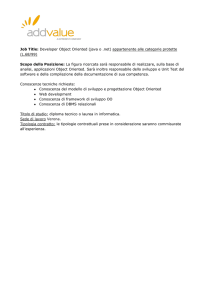
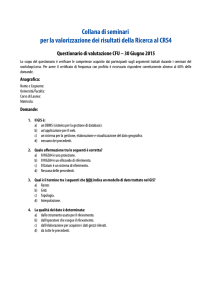
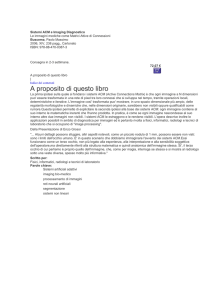

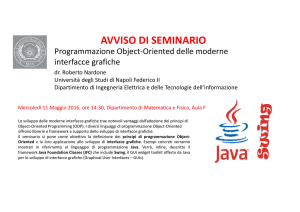

![Scheda del progetto [file]](http://s1.studylibit.com/store/data/000925811_1-915cc2ff1bc666a2b057f220bec097d0-300x300.png)
